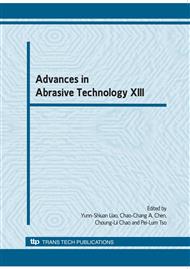p.326
p.332
p.341
p.347
p.353
p.361
p.367
p.375
p.381
Effects of Cutting Fluid with Nano Particles on the Grinding of Titanium Alloys
Abstract:
The use of cutting fluid containing nano particles in wet grinding and MQL grinding of Ti-6A1-4V is studied. For comparison purpose, experiments by applying the general purpose water-based cutting fluid are also conducted. The loading of the grinding wheel and morphology of the ground surface are observed, and the grinding forces and roughness of the ground surface are measured for analysis. It is found that the use of cutting fluid containing nano particles results in less loading of the wheel and better ground surface as compared with those with the use of the general purpose water-based cutting fluid because of smaller grinding forces and coefficient of friction originated from “lotus effect” of nano particles. MQL leads to better results than wet grinding. This is attributed to the possibility of more nano particles to effectively reach the grinding zone by the assistance of the high pressure air of MQL, which in turns enhances the functions of nano particles in alleviating wheel loading and decreasing coefficient of friction. Based on the experimental results, it is concluded that the use of cutting fluid containing nano particles has positive effects on grinding. Especially the MQL, not only can it achieve the best performance, it is also cost effective and environmentally attractive.
Info:
Periodical:
Pages:
353-358
Citation:
Online since:
August 2010
Authors:
Keywords:
Price:
Сopyright:
© 2010 Trans Tech Publications Ltd. All Rights Reserved
Share:
Citation:


